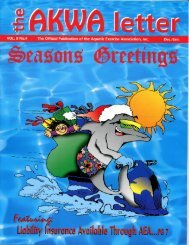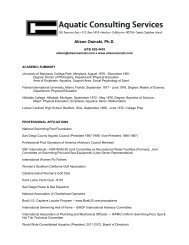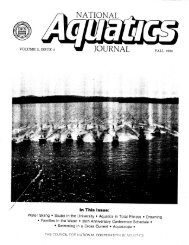a PDF of article
a PDF of article
a PDF of article
Create successful ePaper yourself
Turn your PDF publications into a flip-book with our unique Google optimized e-Paper software.
THE JOURNAL OF APPLIEDRESEARCH IN COACHINGAND ATHLETICSEOBLBHED BY ACADEMIC UBRARYnSEVOLUME Z NO 3, JULY 1987
THE JOURNAL OF APPLIEDRESEARCH IN COACHINGAND ATHLETICSPublished by Academic LibraryEDITORSDr. Arnold LeUnesTexas A&M UniversityDr. J. Steven PicouTexas A&M UniversityDr. Warren K. SimpsonThe Pennsylvania State UniversityTht Journal <strong>of</strong> Afplicd Rrscanlt in Coaching aiul Alhlelics is published in the months <strong>of</strong>January, April, July, and October. Contributions prepared in accordance withguidelines set forth in the PuHicalion Manual <strong>of</strong> the American Psychological Associalion.Thinl Blilion should be sent to the editors. Subscriptions and requests for adver¬tising rates should be addressed to Academic Library, 520 Commonwealth Av.,Boston, MA 02215-2605.Subscription price is $20.00 U.S. / $24.00 Intl. for four issuesSingle copies can be purchased for $6.00 each U.S. / $7.00 each Intl.
The EditorsArnold D. LeUnes, Ed.D.Texas A&M UniversityJ. Steven Picou, Ph.D.Texas A&M UniversityWarren Keith Simpson, Ed.D.The Pennsylvania State UniversityReview BoardAudwin AndersonTexas A&M UniversityDavid BacharachSyracuse UniversityC. Richard BeachNorthwestern CollegeEdward C. BurtConnTex International SportsTimothy CurryThe Ohio State UniversityJoseph A. DeBellaLoras CollegeJed FriendTexas A&M UniversityWilliam S. HusakLong Beach State UniversityGerard G. LyonsMurray State UniversityJack NationTexas A&M UniversityRicardo Nunez-BentzUniversity <strong>of</strong> Puerto RicoCheryl C. NorthamMcNeese State UniversityRonald L. RainwaterHardin-Simmons UniversityAgencyKathy StiversUniversity <strong>of</strong> New MexicoLeroy Sutherland, Jr.University <strong>of</strong> Texas at AustinKay ThigpenUniversity <strong>of</strong> Texas at TylerJoel ThirerIllinois State UniversityJohn WarfieldUniversity <strong>of</strong> Texas (Austin)Jim YoungHuman Performance Institute
ContentsAdult Spectator Verbal Behaviorduring a Mustang League World Series ...........141Nell Faucelle and Alison OsinskiManaging for Survival in Higher Education:Athletics in Academe ............................153Wil/m»i F. Sleir, Jr.Hypnosis: Its Use in Sport .......................168Joseph L AlbiniPlyometrics in Athletics .........................185Ray De Spain and John M. ChevrelleThe Establishment and Maintenance<strong>of</strong> Fundamentals through Drilling ................198Bryan Briddell
IARCA1087. 2.141-152141Adult Spectator Verbal BehaviorDuring a Mustang League World SeriesNell FaucelleAlison OsinskiSan Diego Sfnfe UniversiiyThe purpose <strong>of</strong> this study was to descriptivelyanalyze the verbal behaviors <strong>of</strong> adult spectators during youth baseball Mustang League World Series. Within afour-day period, sixty-four adult supporters wereobserved during 11 games. An interval recording formatwas used to note the "content" and "target" <strong>of</strong> these ver¬balizations. Statements made by observed spectatorsduring 10-second intervals were judged to be eitherpositive, neutral, or negative. Additionally, notationswere made <strong>of</strong> the person(s) to whom the verbalizationwas directed as well as whether the team the adult wassupporting was ahead, behind, or tied. The gender <strong>of</strong> thesubject making the statement was also noted. Resultsshowed that spectators spent over 80% <strong>of</strong> their timedoing such things as silently watching the game orchatting with friends. Also, the data indicated that whenverbal comments were made, most were nuetral (9.11%)or positive (7.03%) in tone. Negative comments ac¬counted for only 1.15% <strong>of</strong> the intervals.Approximately 17 million American children par¬ticipate in youth sport programs (Gould & Martens, 1979).Orlick and Botterill (1975) suggest that children's primaryVOL. 2. NO. 3, JULY. 1987
142SPECTATOR VERBAL BEHAVIORmotivations for such participation are their desires foractivity and fun. Other purposes for such programs areadults' wishes to familiarize children with the funda¬mentals <strong>of</strong> a game and to provide them an opportunity toplay in a safe and supervised manner.However, researchers in the field frequently expressserious concerns about potential detrimental effects fromthe stresses <strong>of</strong> competition and parental pressuresassumed prevalent in youth sports (Brower, 1979;Coakley, 1986; Martens, 1980; Michener, 1976; Ogilvie,1979; Tutko & Bruns, 1976). According to a study by Smolland Smith (1980), youth soccer players on losing teamswere considerably more likely to experience postgamestress than those on winning teams. Perhaps surprisingly,the researchers found that winning did not mean a greatdeal to any <strong>of</strong> the participants. However, the children didfeel that winning was very important to their parents andcoaches. What is more, when compared to players on thelosing teams, the winning team players felt more stronglythat their coaches liked them, and that their parents likedtheir coaches. Children <strong>of</strong>ten imitate the actions <strong>of</strong> adultrole models and internalize attitudes they assume liebehind those actions. Adult role models play major roles indetermining how children will react to competitioninducedfrustration and stress, and how children expressfeelings about their performances in the game.Though the impact <strong>of</strong> adult spectators' verbal be¬haviors on children could be dramatic, few studies havefocused on this element <strong>of</strong> youth sports. Forbis (1977)explored the relationship between perceptions, attitudes,and behaviors <strong>of</strong> parents while watching their children'shockey game. Graham, Raliffe, Faucette, Salter, andWalley (1982) analyzed the verbal behaviors <strong>of</strong> adultspectators attending youth baseball, soccer, and basketballgames. Randall and McKenzie (in review) observed verbalbehaviors <strong>of</strong> adult spectators attending youth soccergames. The purpose <strong>of</strong> this study was to descriptivelyJOURNAL OF APPLIED RESEARCH IN COACHING AND ATHLETICS
SPECTATOR VERBAL BEHAVIOR 143analyze the verbal behaviors <strong>of</strong> adult spectators during ahighly competitive Mustang League World Series (youthbaseball).MethodsThe study was conducted during a four-day MustangLeague World Series for children living in Texas andMexico. Participants in the baseball tournament were 9 or10 years old. Each <strong>of</strong> six teams included in the program hadwon four tournaments preceding the World Series.The sample <strong>of</strong> 64 adult spectators (subjectively judgedto be 18 years old or older) included 35 females and 29males. According to the organizers <strong>of</strong> the tournament, themajority <strong>of</strong> the spectators were parents or closer relatives<strong>of</strong> the participants. Four <strong>of</strong> the six teams had traveled tothe tournament and were housed in a nearby hotel.Although teams were eliminated during the 4-day process,the majority <strong>of</strong> players and spectators continued to attendthe World Series until after the championship game.OBSERVATIONAL RECORDING FORMThe instrument (see Figure 1) used in this studydevelopedby Graham et al, (1982)—incorporated an inter¬val recording format to note the "content" and "target" <strong>of</strong>adult spectator verbalizations. Statements made byobserved spectators during 10-second intervals werejudged to be either positive, neutral, or negative accordingto the following definitions:Positive—A statement that was supportive, encour¬aging, or praising (e.g. "great--------," "good--------,""you can do it," "fantastic," "way to watch the ball,""nice try," "pretty," "beautiful," "that's the way to go,""excellent," "youll get it next time," "yeah (yes)," "allright").VOL. 2, NO. 3, JULY, 1987
om>73nzno>oZn>zoap-mHOObaanr«r aM_ CoatMtr_ T»ri«tM_ CoatMtr_ T>r«at1N_ Coataatr_ T>riLt OtSIXVlTIMlL UCOROIB lOINData__________________ftalUMUtyi !••______ la .1 2 J k J 6 T 8 9 10 ii 12 1? Ik 1? 16 •T 18 '? 20 81 22 *} 8k *? 86 27 88 *? JO(A. B. T) (A. 1. T) (A. (. T)1 2 3 k 5 < T 8 9 10 11 12 13 Ik 15 1< 17 18 19 20 81 22 23 2k 25 26 27 28 29 30(A. ». T) (A. 1. T) (A. I. t)1 2 3 k 5 6 7 8 9 10 11 12 13 Ik 13 16 17 18 19 80 21 22 23 2k 25 26 27 28 89 S>(A. B. T) (A. B. T) (A. B. T)1 2 3 k 5 * 7 8 9 10 11 12 13 Ik 15 16 17 IS 19 20 21 22 23 2k 25 26 27 28 29 30. ( A. B, T) .(A, B. t) ______(A, B, T)COOTiaiTi raaltl>a < nMRi CfclM'a Taaa C OAltf SMUtl Abaad A(antral 0 Oppoalo* Taaa 0 Batelad BX«atl>a - ͣ Coach Ch tia4 TBo SUtaaaat 1 Uaplra UfanFigure 1. Baseball Observational Recording Forminm>HOc:>r-C3mͣx>•
SPECTATOR VERBAL BEHAVIOR 145Neutral—A statement that was neither supportive nordenigrating. Such statements could have been instruc¬tional or commanding with no positive or negativeimplications (e.g. "O.K.," "let's go," "come on," "runhard," "hit it," "catch it," "throw it," "get ready," "keepyour head up," "maybe next time," "don't give up").Negative—A statement that was unsupportive, dis¬couraging, or dinigrating. Such statements includedcursing, disputing an umpire's call, yelling instructionsto the coaches, and giving disruptive instructions tocompetitors in order to hamper their play (e.g. "No!,""bad_____," "that's not what you're supposed to do,""Oh, no!," "drop it").Additionally, notations were made <strong>of</strong> the person(s) towhom the verbalizations were directed. Target choicesincluded players on the team supported by the observedspectator, players on the opposing team, coaches, umpires,and other spectators.Along with notations <strong>of</strong> the "content" and "target" <strong>of</strong>the verbalizations, recordings, were made <strong>of</strong> whether theteam the adult was supporting was ahead, behind, or tied atthe time <strong>of</strong> the statement. The gender <strong>of</strong> each observedspectator was also noted.DATA COLLECTION PROCEDURESPrior to the World Series, two observers were trainedin the use <strong>of</strong> the observational recording form. After threepractice sessions at other youth baseball games, aminimum interobserver agreement <strong>of</strong> 80% was reached.Interobserver agreement was calculated by dividing thenumber <strong>of</strong> agreements by the number <strong>of</strong> agreements plusdisagreements and multiplying by 100 (Hensen & Barlow,1976). Only intervals where both observers recordedspectator behavior were scored.At the beginning <strong>of</strong> each game, four adult subjectswere identified through a standard method <strong>of</strong> randomVOL. 2, NO. 3, JULY, 1987
146 SPECTATOR VERBAL BEHAVIORselection. Shortly, after the games, had begun, observersbegan coding verbal behaviors <strong>of</strong> Subject 1 for 10, 10-second intervals. Observers were cued for a 10-secondobserve/5-second record format by a prerecorded audiotape. After the 10 intervals were completed for Subject 1,observers then began observing Subject 2 for 10 intervalsand this rotation continued through all four subjects forthree complete cycles. When the game was interrupted by atime out, the tape recorder was stopped and recordingceased until play resumed.A total <strong>of</strong> 11 games were observed during the 4-daytournament. Interobserver agreement data on the"content" and "target" categories were collected during 6<strong>of</strong> the 11 games (54%). The mean agreement for bothcategories was 89.3%. During the remaining 5 games, thetwo observers separated and each observed four differentspectators. Because the observations were limited to such asmall number <strong>of</strong> games, this method was used to increasethe number <strong>of</strong> subjects observed.Results and DiscussionAlthough relatively few statements were madeoverall, results were analyzed as to statement content,statement direction, and statement content relative togame score. Additionally, content <strong>of</strong> statements made bymale and female spectators was analyzed.STATEMENT CONTENTOf the 1,920 10-second intervals from which datawere recorded, only 332 spectator statements wererecorded for an average <strong>of</strong> 5.18 verbalizations perspectator. Therefore, approximately 83% <strong>of</strong> observedspectators' time was spent silently witnessing the games.During these periods, spectators spent most <strong>of</strong> the timewatching, reading, talking with .friends, or engaged inJOURNAL OF APPLIED RESEARCH IN COACHING AND ATHLETICS
SPECTATOR VERBAL BEHAVIORother activities unrelated to the competition (see Table 1).Spectators spent the remaining 17% <strong>of</strong> the time periodverbally responding to the activity with neutral, positive,or negative comments.CategoryTable 1Adult Spectator Statementsat the Mustang League World Seriesn = 64Number%1588 82.71No Statement135 7.03Positive175 9.11Neutral221.15Negative1920Regarding the content <strong>of</strong> statements occurring 17% <strong>of</strong>the time, 9.11% were judged to be neutral, 7.03% wereconsidered to be positive, and 1.15% appeared to benegative. These results were similar to those found byGraham et al. (1982) and Randall and McKenzie (inreview). Although, in this study, the level <strong>of</strong> competitionwas more intense, the frequency <strong>of</strong> comments increasedonly slightly. Although all the studies found neutralstatements to be the most prevalent, this study reflectednearly equal numbers <strong>of</strong> positive and neutral statements.Perhaps the increased number <strong>of</strong> positive statements andthe decreased number <strong>of</strong> neutral, coaching statements inthis study may have been the result <strong>of</strong> the overall higherskill level <strong>of</strong> the children involved in such an elitecompetition.STATEMENTS TARGETSStatements were overwhelmingly (94.6%) targeted atthe spectator's child or the child's teammates (see Table 2).VOL. 2, NO. 3, IULY, 1987147
J48 SPECTATOR VERBAL BEHAVIORTable 2Direction <strong>of</strong> Adult Spectators' StatementsChild'sOpposingCategoryTeam Team Coach Umpire FanStatement no. % no. % no. % no. % no. %Positive 133 40.1 0 0 0 0 2 .6 0 0Neutral 173 52.1 0 0 0 0 1 .3 1 .3Nesative 8 2.4 9 2.7 0 0 5 1.5 0 094.62.702.4.3Fifty-two percent <strong>of</strong> the statements targeted to the specta¬tors' favored team were neutral. Positive statements weredirected at the favored team 40.1% <strong>of</strong> the time, and only2.4% <strong>of</strong> these comments were judged to be negative. Nostatements were directed at the coaches but 2.7% <strong>of</strong> thenegative statements were directed at opposing teams. Ofthe very few statements directed toward umpires (2.4%),1.5% were found to be negative. Graham et al. (1982) andRandall and McKenzie (in review) also found that mostcomments by adult spectators during youth sport activitiesare directed toward the fan's team. These researchersfound that most comments in these settings are primarilyinstructional or neutral in nature. Therefore, the primarydifference highlighted in this study was the increasednumber <strong>of</strong> positive statements directed toward spectators'favored players.STATEMENT RELATIVE TO SCOREOverall, the majority <strong>of</strong> verbal behaviors observed oc¬curred when the spectator's favored team was behind(56.6%) (see Table 3). These statements were both neutralJOURNAL OF APPLIED RESEARCH IN COACHING AND ATHLETICS
SPECTATOR VERBAL BEHAVIOR149(32.2%) and positive (19.6%) in tone. Statements weremost <strong>of</strong>ten negative when the spectator's team wastraining — 4.8% <strong>of</strong> the verbalizations as compared to 1.8%when the team was ahead. No negative statements wereobserved when scores were tied. These results differ fromthe study conducted by Randall and McKenzie (in review)where spectators verbalized the least when their team wasbehind and the most when their team was winning.Table 3Statements <strong>of</strong> Adult SpectatorsRelative to their Team's ScoreCategoryAhead Behind TiedStatement no. % no. % no. %Positive 56 16.9 65 19.6 14 4.2Neutral 62 18.7 107 32.2 6 1.86 1.8 16 4.8 0 0Negative37.4 56.6 6.0STATEMENT RELATIVE TO SEX OF SPECTATORSA higher degree <strong>of</strong> females (F=35, M=29) were chosenin a random selection <strong>of</strong> subjects, suggesting that morefemale spectators were in attendance. Neutral statementswere highest for both males and females. Althoughfemales made more negative statements than males, thetotal number is almost negligible. The female spectators inthis study, as in the Randall and McKenzie (in review)study, were more verbal than the males. Females made anaverage <strong>of</strong> 6.6 verbalizations whereas males made anaverage <strong>of</strong> 3.5 comments. Graham et al. (1982) found maleand female verbalization rates to be similar.VOL. 2. NO. 3,1ULY, 1987
,50 SPECTATOR VERBAL BEHAVIORTable 4Statements Made by Male and Female Adult SpectatorsCategoryStatementMale (n = 29)no. %Femaleno.(«= 35)%PositiveNeutralNegative4256441.1854.903.92931191840.4351.747.83102230Conclusions and ImplicationsThe results <strong>of</strong> this study support the growing conten¬tion among researchers in youth sports that adult(presumably parents) spectators spend most <strong>of</strong> their timein activities unrelated to the game. This contradicts thebelief that, during youth sport events, parents are usuallyhighly attentive and frequently engage in verbal abuse thatdiscourages, denigrates, or overstresses their children.Though the level <strong>of</strong> skill and competition in the Leaguestudied was very high, parents continued to silentlymonitor the game most <strong>of</strong> the time.Addtionally, this study, as compared to other studies<strong>of</strong> adult spectator verbal behaviors (Graham et al., 1982;Randall & McKenzie, in review), reflected an increase inthe number <strong>of</strong> positive statements made to the participantsby adult spectators. One explanation for this increase couldbe the high level <strong>of</strong> skills prevalent among childrenparticipating at this intense level <strong>of</strong> competition. Perhapsthese children's performances more closely resemble those<strong>of</strong> adults. This could stimulate adult identification andpositive response. Another possible explanation could bethat children or teams who receive more frequent positivefeedback respond by achieving higher skill levels.JOURNAL OF APPLIED RESEARCH IN COACHING AND ATHLETICS
SPECTATOR VERBAL BEHAVIORAlso, it would be interesting to know the children'sinterpretation <strong>of</strong> the overwhelming silence from the spec¬tators. Do they internalize this silence as spectators'indifference, criticism, or attentive support? Furtherstudies should attempt to interpret the effects <strong>of</strong> thisspectator behavior on the perceptions, feelings, and skilllevels <strong>of</strong> youth sport participants.ReferencesBrower, J.J. (1979). The pr<strong>of</strong>essionalization <strong>of</strong> organized youthsport: Social psychology impacts and outcomes. Annals <strong>of</strong> theAmerican Academy <strong>of</strong> Political and Social Sciences, 445,39-46.Coakley, J.J. (1986). Sporf in society: Issues and controversies. St. Louis:Times Mirror/Mosby.Forbis, N.K.L. (1977). Intrapersonal, intragroup, and intergroupperceptions, and social attitudes and behaviors <strong>of</strong> parentsas specators in a competitive sport setting. (Doctoral disser¬tation. University <strong>of</strong> Michigan, 1977). Dissertation AbstractsInternational, 38, 1298-A.Gould, D., & Martens, R. (1979). Attitudes <strong>of</strong> volunteer coachestoward significant youth sport issues. Research Quarterly, 50,369-380.Graham, G., Ratliffe, T., Faucette, N., Salter, W., & Walley, P.(1982), August). Adult verbal behavior at youth sport games: A des¬criptive analysis. Paper presented at the meeting <strong>of</strong> the Asso¬ciation Internationale des Ecoles Superieres d'EducationPhysique, Boston, MA.Henson, M., & Barlow, D.H. (1976). Single case experimental designs.New York: Pergamon.Martens R. (1980). Kid sports: A den <strong>of</strong> inequity or a land <strong>of</strong>promise? In R.M. Suinn (Ed.), Psychology in sports: Methods andApplications. Minneapolis: Burgess.Michener, J.A. (1976). Sports in America.dom House.151New York: Ran-VOL. 2. NO. 3. JULY. 1987
,52 SPECTATOR VERBAL BEHAVIOROgilvie, B. (1979). The child athlete: Psychological implica¬tions <strong>of</strong> participation in sport. Annals <strong>of</strong> the AmericanAcademy <strong>of</strong> PoUlical and Social Sciences, 445, 47-58.Orlick, T., & Botterill, C. (1975). Every kid can win. Chicago:Nelson-Hall.Randall, L.E., & McKenzie, T.L. (in review). Spectator verbal be¬havior in organized youth soccer: A! descriptive analysis.Journal <strong>of</strong> Sport Behavior.Smoll, F.L., & Smith, R.E. (1980, July-August). Putting winninginto perspective. Sports Line. 1, 3, 8.Tutko, T.A., & Bruns, W. (1976). Winning is everything and otherAmerican myths. New York: MacMillan.JOURNAL OF APPLIED RESEARCH IN COACHING AND ATHLETICS












